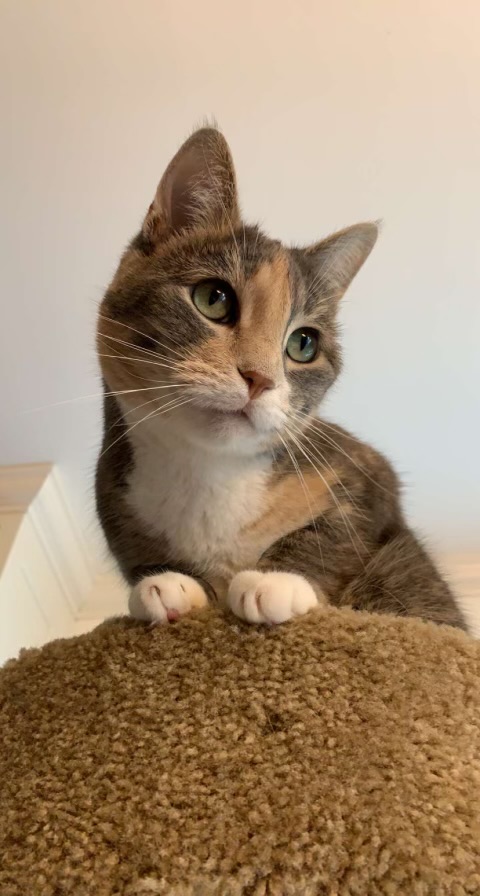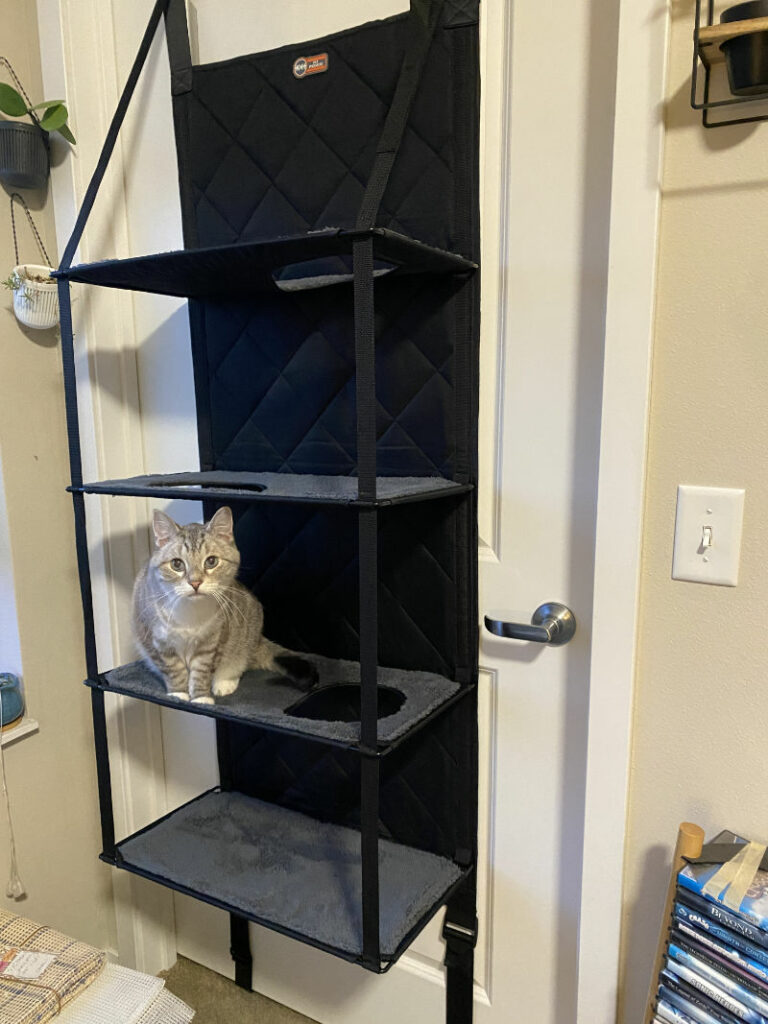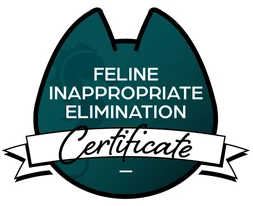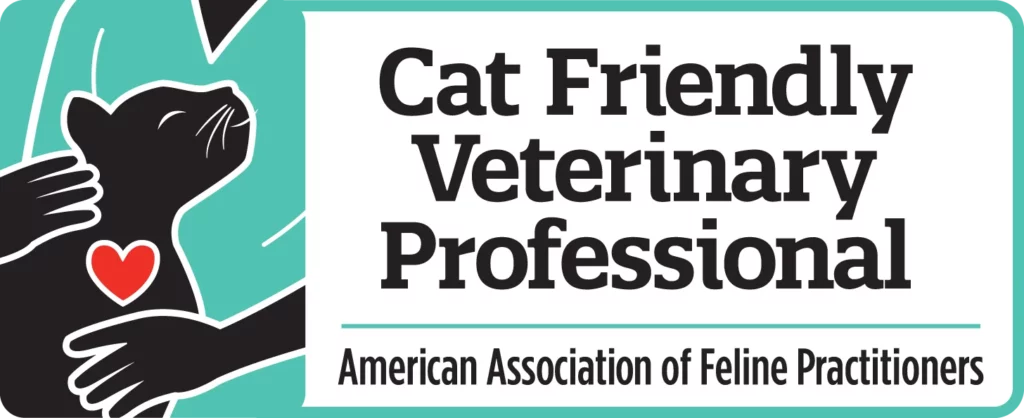This blog post is dedicated to Slinky, a very sweet cat who will soon be living in a small space and very, very happy.

When browsing social media, I sometimes find posts about people searching for a new home for their cat. The reasons vary, but one of the more common themes I see is people who feel that their cat needs to live someone else because living with cats in small spaces isn’t possible.
If you’re one of those people, I am here with some good news: not only is living with cats in small spaces possible, but cats can be happy living in small spaces. Whether you are living with a cat in an apartment, a dorm, a manufactured home, or somewhere else, there’s no need to rehome your cat just because of where you live.
That said, there are some caveats to this and it requires some planning. You may need to sacrifice some of your own space to fit in things to meet your cat’s needs, but it’s completely doable. Let’s go over some considerations.
How Much Space Do Cats Need?
First things first, there is such a thing as too small of a space for cats. No, even the overpriced “luxury” studio apartments that have popped up all over Minneapolis in recent years likely aren’t too small to happily house a cat. As long as your cat has at least 20 square feet of space that is their own, they’re likely going to have their minimum needs met (though more space is clearly ideal). Unless you’re living in a closet, you likely have at least that much space.
That said, I wouldn’t dare stuff a Bengal cat into 20 square feet of space and expect them to be happy. Breeds that are more energetic, younger cats, and cats of any breed or age that frequently get the zoomies may not do well in smaller spaces.
Having multiple cats, even if you have 20 square feet per cat, is going to be more challenging as well. Cats that are more territorial are going to feel more threatened by the presence of other cats in their space and there will be little space for fighting cats to remain separate from each other. It will also take a lot of catification in order to keep all cats happy so you may want to carefully reconsider adding a second (or third or fourth or…) cat if you are short on space.
Living With Cats In Small Spaces Starts With The Environment
You’ll notice that the 20 square feet requirement per cat didn’t specify anything about the whole space being in one place. In fact, cats actually prefer their resources spread out and in strategic locations. Additionally, while we think of “space” as being horizontal space, cats are natural climbers and can take advantage of vertical space.
The single best thing you can do to help cats be happy in their space is to add in vertical space. In small spaces, vertical space becomes non-negotiable as otherwise the cat simply won’t have enough room to climb, run around, and feel secure.
Be Strategic With Vertical Space
That doesn’t mean that you should randomly throw up a cat tower. As space is at a premium, planning ahead to maximize the horizontal space will keep you, your cat, and any other humans who live with you happy. You’ll want to look for as tall of a cat tower as you can find that has a sturdy base but doesn’t take up too much floor space. For safety, you may want to make sure it gets secured to a nearby wall.
Why go for as tall of a tower as you can? Every platform, hammock, or cave adds more space to your cat’s world. Rather than getting multiple small towers that add a small amount of space, one big one will maximize the space added. If you can fit more than one tower in and place the second one in a different location, that’s even better. If not possible, do your best with the tower you can fit.
Make Use Of Space You Aren’t Using
Towers aren’t the only option to add vertical space you have and I’d encourage you to consider a few non-tower options as well. Window perches or over-the-door cat towers can add places for your cat to climb while not taking up space that you might need. Most people don’t spend too much time standing in front of their doorway, but if you do no judgment whatsoever.
I personally really like the over-the-door cat tower made by K&H Pet Products (who have a lot of other excellent products as well) as it’s well made, easy to install, and you can choose from a few different sizes. I encourage you to go for the bigger size to add in the maximum space you can, but any additional vertical space is helpful.

While not an option for everyone, if you are able to drill holes in your walls, cat shelves are a great idea to make use of space you aren’t using. They take up a bit of space as you need to have a way up and down for your cat, but once you have them up high enough, you can keep the shelving entirely above most people’s heads.
Make Your Cat Furniture Multitask
Most cat towers have scratching posts built in so you can put two important resources for cats in one spot without taking up extra space. With space being limited, you want to try to double (or triple) up as many resources as you can. If you can add something for your cat to climb, scratch, hide, and/or play on in one location, it limits the number of things you need to get for them. You still want resources in multiple places and the litter box should absolutely be separated from food and water, but you can maximize each area by making them multifunctional.
Making things multifunctional isn’t limited to cat furniture, either. You can modify other furniture to add cat resources to them so you get use out of something and your cat can get a need met as well. The easiest way to do this is going to be using bookshelves and cabinets to allow your cat to climb or have a hiding spot, but you can get creative. Consider an over-the-arm cat scratcher which will both protect your furniture and give the cat something to scratch on. Plus, it has storage for remotes or other small items.
Separate The Litter Box… Creatively
One particular challenge may come with separating the litter box or litter boxes depending on how many cats you have. Ideally, you’d want food and any water fountains or bowls in completely separate areas. If you can’t do that, try to get them as far apart as you can. If your space really isn’t big enough to do that, consider feeding your cat up higher or adding in a visual barrier of some sort so there’s at least some separation.
One caveat to the above: I do not recommend using a covered box and feeding your cat on top of it. That’s just gross!
Meet Their Mental Needs
Besides the environment, your cat needs more mental stimulation than you’d think or they may end up with unwanted behaviors. Thankfully, this is pretty easy to add into small spaces. Depending on the exact amount of space you have and your budget, there are a few ways you can go about doing this.
Encourage Your Cat To Move
Cats need plenty of play and exercise that imitates a full hunt cycle. If you are living with cats in small spaces, they don’t really have as much room to run around as they would in a larger space. You can use an interactive wand toy to encourage them to climb up and down cat trees, jump on couches, or even just move around a table. To make play more interesting, you can even temporarily alter the environment by tossing some pillows or boxes on the ground to create a more interesting hunt that they’ll be excited about.
If you have the space and budget, some cats may like using an exercise wheel. They may need to be encouraged to use the wheel at first, but many cats will enjoy the extra movement. Keep in mind that cats have individual preferences. Much like you may not enjoy running for fun, not all cats will like running on an exercise wheel. It also shouldn’t be their only source of entertainment. Focus on play!
Add In Passive Enrichment
You can add in things that don’t take up much space to keep your cat interested day to day. Growing some cat grass for them to munch on, adding a window perch so they can watch the birds outside, or using a food puzzle can help your cat remain mentally stimulated. If you have a tablet or other device, you can leave it on to cat-specific videos so they have something interesting to watch.
Electronic toys are hit or miss with cats as the noises can be scary for some cats, but there are a few options that may help keep your cat occupied without taking up much space. A ball or feather on a string may entice a cat while this butterfly toy is to be a hit among cats that aren’t noise-sensitive.
Train Your Cat
A final idea for mental stimulation? Training your cat. Training is fun and predictable for cats so it gives them a chance to think a bit and get rewards. You don’t necessarily need to train anything in particular so you could teach your cat fun tricks or how to do more useful behaviors. Adapting some of the exercises from Control Unleashed is also a great option. If you want to give training a try, you can either purchase a training kit or I offer private lessons on cat training. Lessons are done virtually so we can meet wherever you are!
Can Cats Be Happy Living In Small Spaces?
I hope by now, you’re thinking of all the ways you can add things to your home to make your cat happy because living with cats in small spaces is absolutely possible. Cats can thrive in small spaces so no need to rehome your cat just because you are in a small space. Even if your budget is tight, there are ways you can make your own cat furniture or find low-cost supplies. Check your local Buy Nothing group as chances are someone’s cat didn’t like something they purchased and you can take advantage of it.










